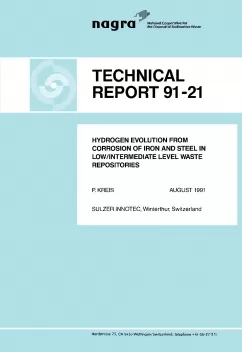
Technical Report NTB 91-21
Hydrogen evolution from corrosion of iron and steel in low/intermediate-level waste repositories
The production of hydrogen from the corrosion of iron or steel is an important issue in low/intermediate level nuclear waste repositories where large quantities of iron and steel (e.g. as drums and reinforcing steel) accompany the waste.
Most of the iron in low/intermediate level repositories is in a cementitious environment. A review of the literature on the corrosion of iron and steel at high pH values, in particular in cementitious environments, points to hydrogen evolution rates between 22 and 220 mmol (H2)/(m2*a). There is some indication that the rates might be lower but for normal engineering applications there has been no practical need to demonstrate this, and hence a lower rate cannot be assumed on current evidence.
Near field analysis shows that hydrogen evolved at these rates will not be dissipated by diffusion of dissolved hydrogen. This may have various consequences, for example displacement of water from the near field and, if the gas cannot escape, mechanical disruption of the host formation cannot be ruled out because of equilibrium pressures in excess of 500 bar.
In the present work the hydrogen evolution rates of corroding iron in strongly alkaline and neutral media were measured during a period of at least 6000 hours, using a volumetric method. The sensitivity of this method is sufficiently high (0.1 mmol/(m2*a) to determine lower hydrogen evolution rates than those previously assumed for iron and steel in cement.
Selected as alkaline media were on the one hand solutions of the free bases NaOH, KOH, Ca(OH)2, and on the other hand three synthetic cement pore waters. The pH of the solutions ranged from 12.5 to 13.
In general the hydrogen evolution rates found were below the 22 – 220 mmol(H2)/(m2*a) postulated above. Nevertheless despite similar pH there were distinct differences between the corrosion behaviour of the monovalent (NaOH, KOH) and bivalent Ca(OH)2 solutions.
While the Ca(OH)2 solution shows a practically constant hydrogen evolution rate of 1 – 2 mmol/(m2*a) throughout the measuring period, the monovalent solutions reach a maximum around 13 mmol/(m2*a) after about 2000 hours, dropping below 4 mmol/(m2*a) in the course of 6000 h.
Accordingly an aged cement pore water containing only Ca(OH)2 as free base produces hydrogen at a constant value of 0.5 – 1 mmol/(m2*a). It must be assumed that new cement pore waters containing much free NaOH and KOH behave according to the free bases, although the measuring time of 6000 hours was too short for any exact statements.
Employed as neutral media for the tests were Böttstein water (a synthetic granitic deep water), bidistilled water and a solution of pH 8.5 containing 8000 ppm chloride. All three media revealed a similar picture in principle, qualitatively and quantitatively. After a starting phase of about 1000 hours with hydrogen evolution rates of 80 – 100 mmol/(m2*a), the values begin to fall in the course of 6000 hours to 10 – 20 mmol/(m2*a). The results measured during the starting phase agree in order of magnitude with earlier results (Schenk 1988), but since corrosion measurements covering several thousand hours are rare or nonexistent, a comparison with results from earlier published works is difficult.
